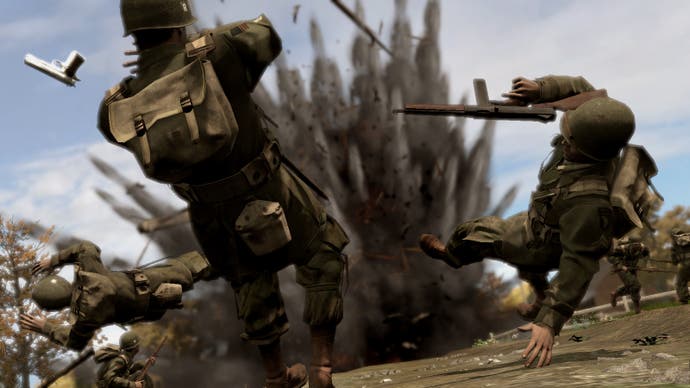Brothers In Arms: Hell's Highway
We invade France in search of answers.
Having not previously joined up with Gearbox's award-winning fraternity of Spielbergean flankers, I landed in France for my UbiDays briefing with intel rather than brutal experience ringing in my ears. Oli Clare's point-by-point dissection of 2005's Earned In Blood had given me an idea of what to look for, and my report back to him reads like a point-by-point rebuttal of his lingering doubts.
What's with all the bullet-proof wood, he asked? What indeed, retorts the next-gen tech underpinning Hell's Highway, as developer Randy Pitchford hoses a group of ignorant Germans bedded down behind a picket fence. "I don't remember seeing this in a game before," he says, as the wood frays, splits and disintegrates convincingly under the weight of lead. "Now you learned something valuable today," says military advisor Colonel John Antal; "do not hide behind a wooden fence when somebody's shooting at you." Not in this one, anyway.
Why couldn't the troops in your unit clamber over low walls? Now they can. When you're not firing with the right-trigger, FPS-style, you're directing units with the left-trigger icon system you're familiar with, and you can add a jump button input to have them leap over a waist-high stone wall rather than circling it. Why wouldn't they go prone before? Well, now they do. Why were grenades so hard to hurl? Hard to say if this has changed, since Pitchford's not giving us that pad (and we reckon Antal could probably take us if we moved for it), but it'll be worth persevering: a grenade rolled under a cart brings the camera in for close-up, slows down the action and then erupts, carrying wood and limp German bodies away in arcs of unscripted victory. Pitchford giggles. He keeps doing something on-screen and then pausing to add, "Details." God is in them, of course, and he - or whoever's programming is behind what happens when a pineapple goes boom - is ripping wood apart more credibly than we've ever seen in a game.

With apologies to Oliver, we have no answer to whether you can always put a slug through things in sight, but as for his concern that our World War II education is being distorted by this German army's obsession with loading the Normandy countryside with crates, barrels and oil drums - judging by the town of Son, through which the returning Sergeant Baker and his hardened squad are fighting in our demo, they didn't get round to stocking up Holland. Here the cover's more convincing - low stone walls, crumbling masonry, hastily-deployed sandbags, farming equipment and, of course, picket fences. Fine, there were a few barrels, too. But then Holland was home to a lot of explosives in September 1944, when the 101st Airborne - Baker's company - took part in Operation Market Garden. Ultimately, the fifth bridge they approached was blown before they could reach it. The bridge at Son.
How those events tally with what happens on Hell's Highway is unknown, but just as Colonel Antal insists the game is the most realistic simulation of battle tactics around, Pitchford hypes up the scenario. "Sgt. Baker in the first game learned to be a squad-leader... Now he's learning what it means to be a squad-leader; how to deal with it; the sacrifice you have to make," he says. As Baker enters a house in a cut-scene, he finds some round-rimmed glasses, which give him a sepia-tinted flashback of a dead comrade - Benjamin Legget from the first game. "There's a deep character story here - it's about the burden of a squad-leader. The memory of this dead man haunts Baker. Will it drive him insane or can he come to grips with it and move forward?" With technology more firmly on Gearbox's side this time, there's a range of subtle ideas at work to engage the player in combat. "Brotherhood moments" - when the youngster slips, and the team leader grabs him to his feet at a canter - will blend naturally into situations, and while they may only have a minimal effect on gameplay conditions, they're not about that; they're minute acts of instinctive AI heroism that feed into a more involving whole.


